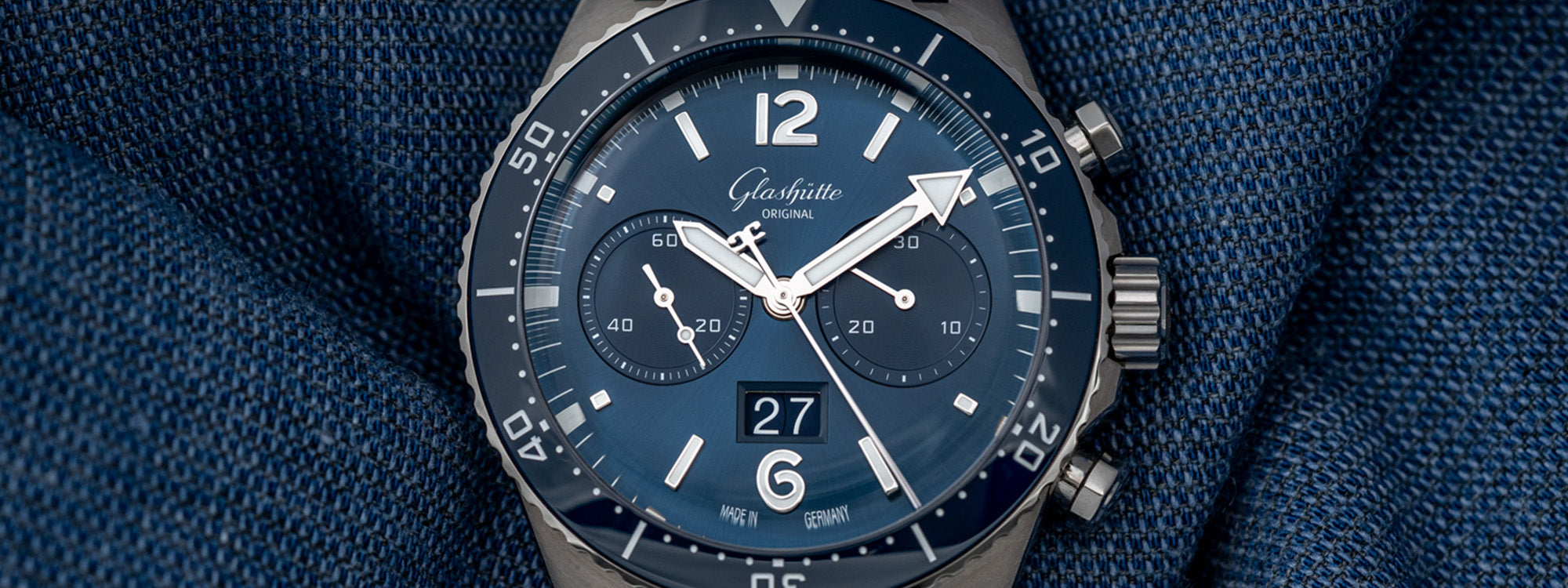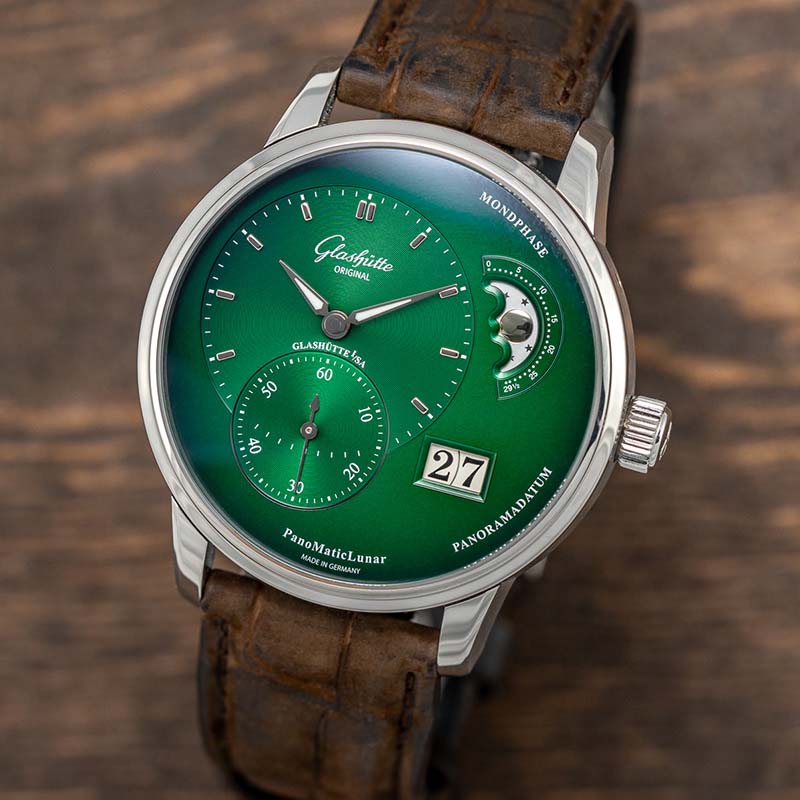While it was established relatively recently, in 1994, Glashütte Original can legitimately trace its lineage as far back as 1845, which also happens to be the year that watchmaking essentially arrived as an industry in Germany. As I cover in much greater detail in this article, a full century of horological tradition, centered in the town of Glashütte in the state of Saxony, came to an end with Germany’s defeat in World War II. It was replaced by a new era in which a state-owned conglomerate of once-independent heritage watch manufacturers, the Glashütter Uhrenbetriebe or GUB, shifted focus from artisanal techniques and luxuriously decorative timepieces to mass-produced tool watches for military and civilian customers. Many of the watches produced in the GUB era — spanning the Cold War years from 1951 up to the fall of the Berlin Wall in 1990 — are largely forgettable, but Glashütte Original, the luxury-watch firm that emerged from the dissolution of the GUB, has cherry-picked the most interesting and memorable of those utilitarian timepieces, produced in the late 1960s and ‘70s, for modern reimagining in its “Spezialist” series.

Serving as the base model for the Spezialist models is a single, now-collectible divers’ sport watch from 1969, the Spezimatic Type RP TS 200, which was the first dive watch produced in Germany (technically, at the time, East Germany) that met the international ISO 6425 standard. Glashütte Original paid tribute to the fondly remembered watch in 2019, its 50th anniversary, with the first Spezialist SeaQ watches. Like their predecessors, the SeaQ models are serious dive watches, compliant with both the aforementioned ISO standard as well as Germany’s own DIN 8306 standard and water resistant to 200 meters. More versions of the SeaQ followed in various dial colors (like the "Reed Green" model above), some with Glashütte Original’s hallmark Panorama Date, all equipped with modern manufacture calibers. The first chronograph version of the SeaQ arrived in 2023, debuting in a suitably maritime-influenced dark blue livery. I jumped at the opportunity to go hands-on with the SeaQ Chronograph ahead of its debut in our retail store; my review follows below.
The Case:

The SeaQ Chronograph makes a statement on the wrist with its imposing diameter — just a smidgen over 43mm — and its rather substantial girth in profile, at 12.5mm. Appropriately for a luxury watch with a sporty, tool-watch pedigree, the finishing is predominantly brushed, with meticulously polished facets, including the large indented space between the lugs on either end of the case. The large crown screws down into the case between two shoulder-like crown guards. Its deeply fluted sides make the crown easy to grip and turn, and its top surface has a wave-pattern version of the Glashütte Original “GG” emblem that speaks to the watch’s underwater habitat. Flanking the crown guards on each side are the chronograph pushers in the classical "plunger" or "pump" style, but here with an unusual detail: their sides are not round but octagonal, like a bolt from a workbench. The case’s sides, which flow into short, bluntly curving lugs, have a vertical brushed pattern, outlined by polished facets.

The unidirectional ratcheting bezel also boasts a fluted edge for easy gripping and turning by hands in diving gloves. The indigo-blue insert is made of ceramic and hosts a white-inscribed dive scale with Arabic numerals at the 10-minute markers, indexes at the intervening five-minute points, dots for each minute, and an inverted triangle at 12 o’clock. Strategically placed Super-LumiNova allows the triangle to glow in the dark. Also worthy of note is the case’s water resistance of 300 meters, a rating achieved despite the presence of a sapphire window in the caseback. The design of the screw-down crown is an additional factor in the water resistance: in its second of three positions, it can quickly set or change the large date, eliminating the need for an additional pusher or inset button for this task that would require another opening, albeit a small one, on the side of the case.
The Dial:

The dark blue tones of the bezel are echoed on the dial for a unified and very nautical overall aesthetic. Here is also where we see Glashütte Original’s designers cleverly and creatively adapt the design of the Automatic and Panorama Date versions of the SeaQ into a chronograph. Like its predecessors, the dial has prominent Arabic numeral appliqués at 12 and 6 o’clock and thick indexes on either side of the former, at 11 and 1 o'clock, and the latter, at 5 and 7 o'clock. The other numeral markers are supplanted by two large subdial counters at 3 and 9 o’clock, accompanied by truncated, applied indexes at the intermediate points between 1 and 5 and 7 and 11. The main dial has an understated, velvety sunburst sheen while the subdials, which are situated slightly below the level of the main dial, have a snailed texture that adds depth. The subdial at 3 o’clock records 30 minutes of elapsed time once the chronograph is activated, while the one at 9 o’clock ticks away the running seconds. Both subdials have white-printed tracks and white numerals in a thick, blocky font. As the small seconds are a more important display to be able to read in the dark, that subdial’s hand has a luminous-coated dot on its shaft.

The hour and minute hands appear to also be designed with maximum legibility in mind: both are wide and luminous-coated and their contrasting sizes and shapes make them a cinch to tell apart. The hour hand is sword-shaped and about half the length of the minute hand, which has a wide arrow tip that reaches out almost to the very edge of the dial, breaking the border of its thin minute track. The central chronograph seconds hand uses the “GG” logo as a counterweight. All the hands, indexes, and applied numerals have a rhodium finish that pops them nicely from the depths of blue on the dial.

The Glashütte Original hallmark Panorama Date finds a home on the dial of the SeaQ Chronograph, directly under the center of the hands and right above the numeral “6” at 6 o’clock. More attention to detail is evident under a loupe as one notices the inward-curved faceted frame around the numerals (each on a separate disk) and, of course, the use of white numerals on a dark blue background so that the date harmonizes with all of the other dial indications. The date is the only element on the dial that is somewhat vexing from an aesthetic standpoint. While it balances nicely the white-printed Glashütte Original text below 12 o’clock, it almost seems to compete with the larger “6” numeral directly beneath it and the stacking of the two numerals can make this section of the dial appear a bit crowded. Nevertheless, I appreciated the large date when it came time to use it in a practical circumstance, like when writing a check.
One of the dial’s most intriguing and practical aspects is one that isn’t even noticeable on the surface and likely not to be appreciated unless the watch and/or its wearer encounters an accidental impact. The watchmakers have placed a hollow, hexagonal socket screw, made of stainless steel, in the center of the dial, above the hand shafts. This small construction detail, which fixes the dial to the plate before the hands are mounted, imparts an added level of protection against shocks, making the dial less likely to buckle or warp, and interfere with the motion of the hands, if the watch is dropped.
The Movement:

Inside the case, on display behind a sapphire viewing window in the caseback, Glashütte Original has installed a new, in-house movement, the self-winding Caliber 37-23. It’s based on an existing chronograph caliber also developed by Glashütte Original, the 37-01 that animates chronograph models in the dressier Senator family. The primary difference between the two movements seems to be that Caliber 37-23 dispenses with the analog power-reserve indicator that would otherwise occupy the 12 o’clock position. This is not to say that the power reserve itself is not impressive even though it’s not in plain sight: the watch will run a full 70 hours, nearly three days, once it’s fully wound, an attribute that I found quite helpful during my first few days with the watch, when this review was overlapping with a handful of others and I needed to go long periods without wearing it.

Like the movement it’s based on, Caliber 37-23 is equipped with a flyback mechanism for its integrated chronograph function, allowing the wearer to reset and restart the running central chronograph seconds hand back at zero to instantly start timing a new interval. For this new caliber, Glashütte Original’s watchmakers also expanded the space around the balance, allowing for a precious few extra degrees of amplitude, and thus a more reliable level of precision even while the stopwatch is running. Also aiding in the watch’s reliability is the silicon balance spring, a bulwark against the ill effects of magnetic fields.

The flyback chronograph mechanism operates with a classical column-wheel architecture. As fans of this Saxon haute horlogerie house have come to expect, the decorations on the movement are top-shelf, with Glashütte stripes adorning the mainplate, beveled and polished edges and blued and polished screws throughout, and a skeletonized “GG” rotor with a solid 21k gold weight to wind the mainspring.
The Bracelet:

Glashütte Original offers the SeaQ Chronograph on a variety of bracelets and straps; my review watch came with a soft but sturdy synthetic fabric strap in a matching dark blue; in keeping with the timepiece’s maritime motif, this strap (there’s also a variant in a contrasting gray tone) is made from recycled fishing nets recovered from the ocean. This decidedly sporty strap is nevertheless lent an air of luxury by the double-folding polished steel clasp that securely fastens the watch to the forearm. On the front surface of the buckle closure, we again find the engraved “GG” emblem. Glashütte Original also offers this cloth strap with a simple steel pin buckle closure, and while the folding buckle certainly elevates the watch in terms of upscale finishing, I couldn’t help thinking that the simpler buckle might be preferable when you wanted to put on or remove the watch in a hurry. The devil’s-advocate position on that, however, is that a lighter and less substantial buckle might make this somewhat weighty watch feel a bit unbalanced on the wrist, not that I had the chance to compare this time around. Bottom line, however, is that the fabric strap is perfectly comfortable on the wrist and its color lends the entire ensemble a suitably maritime-evocative spirit — one that will look as perfectly at home on the deck of a yacht as it will during Happy Hour at a beachside bar.
The Glashütte Original Spezialist SeaQ Chronograph on a blue or gray synthetic fabric strap with folding clasp (Ref. 1-37-23-02-81-36) carries an MSRP of $14,700; on the same strap with a pin buckle (Ref. 1-37-23-02-81-09), it costs $14,400. The steel bracelet version with with folding clasp is priced at $15,600.






















































0 Comments